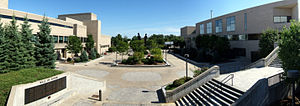With family investments and home values battered by the recent financial crisis, colleges and universities around the nation are seeing an increase in students seeking financial aid and are bracing for even more.

A panoramic picture of the Angell Center courtyard at the State University of New York at Plattsburgh. (Photo credit: Wikipedia)
At the same time, higher education’s ability to meet that extra need is in question because the value of most college endowments has dropped as well. Nationwide, applications for financial aid jumped 16% last fall compared to the previous year. Some colleges may need to cut back on other spending to fund extra scholarships. Others are increasing grants and boosting staffing to help students find loans if their families’ college savings accounts have been hit by Wall Street losses or if they can no longer borrow against their homes.
Before taking steps to reduce financial aid, schools will probably first postpone new construction and stop hiring new faculty. BostonUniversity, for example, announced a construction and hiring freeze, and other schools may follow suit if the situation does not improve.
In recent years, universities with significant endowments have faced pressure from Congress to spend more of the investment returns on scholarships or risk jeopardizing their tax-exempt status.
Another concern is that some financially stressed families may push current high school seniors to apply only to public institutions, like the SUNY (State University of New York) system. I have seen this occur with some of our affluent clients. Despite being able to afford it, they simply cannot justify spending almost three times the money for a selective private college. This has resulted in the SUNY schools, and many out of state publics, becoming highly selective. So parents hoping to send their children to what used to be a “safe” SUNY school, in terms of selectivity, may not have that option. They will still have to pay the going rate for a private college, which can run close to $60,000/year.
The result: More loans, at a time when concerns persist about loan availability if the banking system remains unstable. In addition, many experts are now warning that the student loan bubble will be the next debt crisis in the United States. Average student loan debt has increased to close to $30,000 and many students graduate with more than $50,000 which makes it much harder to start out in their 20s.
At Northeastern University in Boston, about 10% more students than last year have asked for additional midyear aid. Many parents are asking “what if” questions about whether reduced investment values could make them eligible for more aid. So far, Northeastern has been able to meet all legitimate needs.
So what’s the best course of action for prudent parents and students? First, continue to save early, and save often. Second, make sure you begin the college search in 10th grade, or 11th grade at the latest. There are many strategies available to reduce a family’s Expected Family Contribution (EFC), but this must be done before the middle of a student’s junior year. Third, in most cases, saving should be done in the parents’ name. Fourth, depending on the college that students select, home equity or business assets may be included in the financial aid formula. Make sure you understand how the equity in your home or business will affect the college’s estimate of your ability to pay. Finally, consider contacting the College Advisor of New York where we specialize in finding best fit colleges socially, academically, and financially for families of all incomes.


